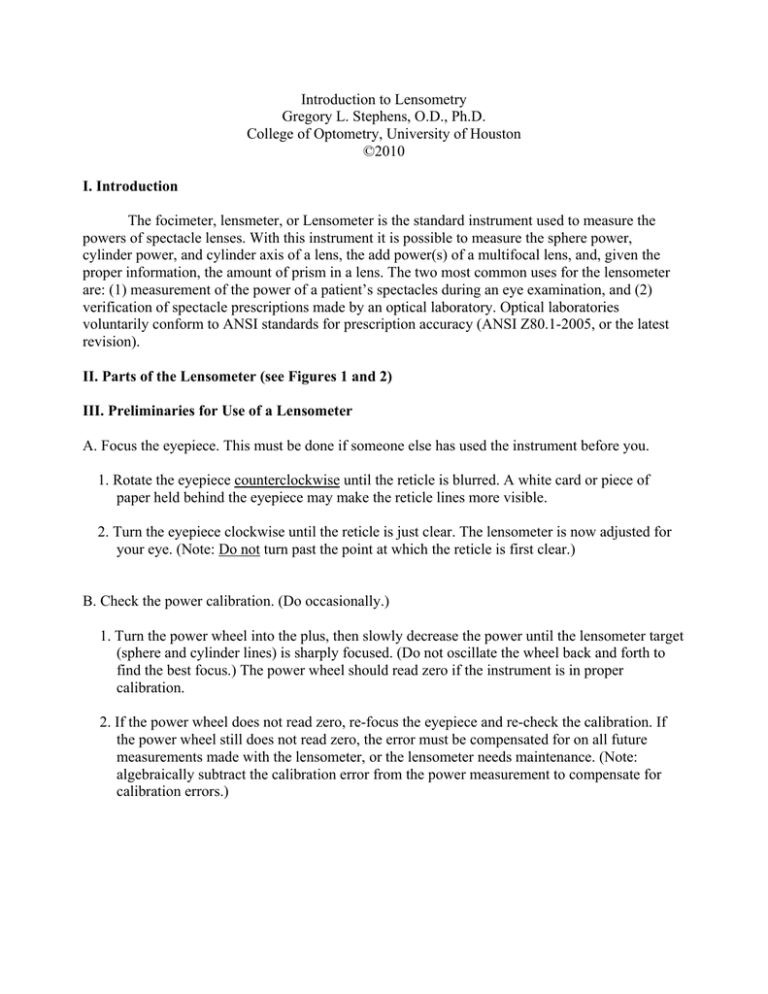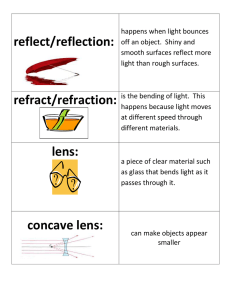Introduction to Lensometry Gregory L. Stephens, O.D., Ph.D. College
advertisement

Introduction to Lensometry Gregory L. Stephens, O.D., Ph.D. College of Optometry, University of Houston ©2010 I. Introduction The focimeter, lensmeter, or Lensometer is the standard instrument used to measure the powers of spectacle lenses. With this instrument it is possible to measure the sphere power, cylinder power, and cylinder axis of a lens, the add power(s) of a multifocal lens, and, given the proper information, the amount of prism in a lens. The two most common uses for the lensometer are: (1) measurement of the power of a patient’s spectacles during an eye examination, and (2) verification of spectacle prescriptions made by an optical laboratory. Optical laboratories voluntarily conform to ANSI standards for prescription accuracy (ANSI Z80.1-2005, or the latest revision). II. Parts of the Lensometer (see Figures 1 and 2) III. Preliminaries for Use of a Lensometer A. Focus the eyepiece. This must be done if someone else has used the instrument before you. 1. Rotate the eyepiece counterclockwise until the reticle is blurred. A white card or piece of paper held behind the eyepiece may make the reticle lines more visible. 2. Turn the eyepiece clockwise until the reticle is just clear. The lensometer is now adjusted for your eye. (Note: Do not turn past the point at which the reticle is first clear.) B. Check the power calibration. (Do occasionally.) 1. Turn the power wheel into the plus, then slowly decrease the power until the lensometer target (sphere and cylinder lines) is sharply focused. (Do not oscillate the wheel back and forth to find the best focus.) The power wheel should read zero if the instrument is in proper calibration. 2. If the power wheel does not read zero, re-focus the eyepiece and re-check the calibration. If the power wheel still does not read zero, the error must be compensated for on all future measurements made with the lensometer, or the lensometer needs maintenance. (Note: algebraically subtract the calibration error from the power measurement to compensate for calibration errors.) 2 FIGURE 1 3 FIGURE 2 4 FIGURE 3 IV. Measuring the Power of a Single Vision Lens (and/or Measuring the Distance Portion Power of a Multifocal Lens) Note: this procedure always measures power in minus-cylinder form. A. Position the glasses on the lensometer by placing the back surface against the lens stop, with the temples pointing away from you. Move the lens table up against the bottoms of the eyewires so the lens is approximately centered on the lens stop, then lower the lens holder gently against the lens front surface. See Figure 3. B. Turn the power wheel into the plus, then slowly decrease the power until the target (Figure 4) starts to focus. If the target is not centered on the reticle, move the lens around on the lens stop to center the target. Exact centration is not necessary at this point. KEY POINT #1: always come down from the plus when measuring power. 5 Figure 4 At this point two different procedures are used, one for sphere lenses, the other for sphero-cylinder lenses. C. Measuring a Spherical Lens 1. If both sets of target lines focus at the same time (Figure 5), the lens is a sphere. Record the lens power to the nearest 0.12 D (regardless of the increment size on the lensometer scale), and you are done. 2. Note: accepted power readings between, for example, -2.00 and -3.00 on the scale are: ------------------------------ -2.00 -2.12 -2.25 -2.37 -2.50 -2.62 -2.75 -2.87 -3.00 3. Always record D.S. or “sph” after the lens power to show it is a sphere, for example: –2.75 D.S. 6 Figure 5 D. Measuring a Sphero-Cylinder Lens 1. If the two sets of target lines cannot be focused at the same time, or both sets of lines appear broken or are blurry (Figure 6), the lens is a sphero-cylinder. Determine the lens power by focusing the sphere and cylinder lines separately, as follows: a. Place one hand on the axis wheel, the other on the power wheel. Starting from the plus, decrease power and rotate the axis wheel until the sphere lines are unbroken and in sharp focus (Figure 7, left). (The sphere lines or line will be the three closely spaced lines or a single line.) The lens sphere power is the power at which the sphere lines focus. b. Record this value as the sphere power of the lens. KEY POINT #2: The sphere lines must always focus at a more plus power (or less minus power) than the cylinder lines. If the cylinder lines focus at a more plus power than the sphere lines, rotate the axis wheel 90 degrees and start over. c. Continue focusing in the minus power direction until the cylinder lines (the widely spaced set of 3 lines) are in focus (Figure 7, right). Do not move the axis wheel. d. The cylinder power is the difference between the focus readings for the sphere and cylinder lines. Record this value in minus-cylinder form. (Give the difference a minus sign.) e. Read the cylinder axis from the axis wheel, to the nearest one degree. f. Write the prescription. Example: O.D. +3.00 -2.00 x 177 7 FIGURE 6 FIGURE 7 2. Examples a. You focus the sphere lines at +3.50 with the cylinder axis set to 150. You focus the cylinder lines at +2.00. The lens power is +3.50 -1.50 x 150. b. You focus the sphere lines at +2.00 with the cylinder axis set to 150. You focus the cylinder lines at +3.50. OOPs- you are 90 degrees off-axis. Rotate the axis wheel 90 degrees and start over. 8 c. You focus the sphere lines at +0.75 with the axis wheel set to 90. You focus the cylinder lines at -0.50. The lens power is +0.75 -1.25 x 90. (Note: when crossing the zero power position, you will need to add the two numbers to get the amount of cylinder. The power change when you go from +0.75 to -0.50 is 1.25 diopters, not 0.25 D.) As another example, if you went from +1.00 to -1.00, the power difference is 2.00 diopters, not zero diopters. V. Summary: 1. Focus the eyepiece. 2. Place the back surface of the lens against the lens stop and the bottoms of the glasses against the lens table. Hold the lens in place with the lens holder. 3. Starting from the plus, slowly decrease power until the target begins to focus. 4. If the lens is a sphere, both target lines will focus at the same time, and the lens power is read from the scale. 5. If the lens is a sphero-cylinder, rotate the axis wheel so the target lines are unbroken and the more plus focus is the sphere line(s). 6. The more plus focus is the lens sphere power. 7. Continue into the minus until the cylinder lines are in focus. 8. The difference between the more plus and more minus focus positions is the cylinder power, in minus-cylinder form. 9. Read the axis from the axis wheel. VI. Improving the Accuracy of Lensometer Measurements A. Keep the green filter in place at all times, except when measuring sunglasses. This filter helps to minimize color aberrations that can affect the focus. B. Lenses with small amounts (0.25 D) of cylinder are the most difficult to measure. It is difficult to set the axis accurately, and it is easy to miss the cylinder (to accidentally call the lens a sphere). To set the axis accurately for small cylinders, look at the positions where the sphere and cylinder lines cross (Figures 8 and 9). If you are off-axis, the sphere lines will appear to tilt slightly where they cross the cylinder lines, and the edges of the lines may appear jagged. C. To be sure that you do not miss a small cylinder, rotate the axis wheel and look for changes at the points where the sphere and cylinder lines cross. If no changes occur when you rotate the axis 180 degrees, the lens is a sphere. D. The axis location for any cylinder is best found by bracketing. First, find what you believe to be the correct axis position. Next, rotate the axis wheel away from this position, first in one direction, then the other, stopping each time when you can tell that the axis is incorrect. The axis will be at the center of the interval over which the axis appears to be correct. It is best to do this process by feel. Do not look at the axis wheel, just estimate the position of the center of the interval by hand. 9 E. When making any power measurement, whether for distance or add power, be sure that the lens is positioned flat against the lens stop (Figure 10). Tilting a lens away from the stop alters the power that is measured. FIGURE 8 FIGURE 9 10 FIGURE 10 FIGURE 11 11 VII. Measuring the Distance Power of a Progressive Addition Lens (PAL) Just measure the power at the circle “a” at the top of the lens (Figure 11), again with the back surface of the lens against the stop. VIII. Measurement of Prism- General Prism is measured using the reticle (the set of black rings visible when focusing the eyepiece of a lensometer) and is specified in prism diopters (Δ). General rules: A. Prism moves (deflects) the lensometer target away from the center of the reticle. The target is deflected in the direction of the prism base. Base directions are up, down, in and out. Base-in and base-out are specified relative to the eye. (This can be confusing.) Base-in (BI) prism is present when the target deflects toward the nose (the bridge of the glasses, or nasally). Base-out (BO) prism is present when the target deflects toward the temples (Figure 12). NOTE: the easiest way to determine the direction when horizontal prism is present is to just compare the target position to the patient’s glasses. If the target deflects toward the bridge, the prism direction is BI. If it deflects toward the temples, the prism direction is BO. FIGURE 12 12 B. The amount of prism is determined using the reticle. For most lensometers, the first ring is ½ prism diopter, the next ring 1 prism diopter. The 1,2,3,4, and 5Δ rings are often labeled on the reticle. The ½Δ ring is not usually labeled. C. Measure the prism at the point where the middle sphere line crosses the middle cylinder line. If cylinder is present, focus back and forth between the two sets of lines to determine where the lines would cross. D. Some Examples- see Figure 13 Note: the prism present for the middle figure of Figure 13 would be 2Δ BO if a left lens was being measured. 1Δ BU O.D. 2 Δ BI O.D. 3.5 Δ BI 2.5 Δ BU FIGURE 13 IX. Finding the Optical Center A. Prism measurement can be complicated because the amount and direction of prism present varies with position on the lens. (To see this, move a lens around on the lensometer. The target moves up and down or sideways or both. This movement is prism.) 1. The optical center is the point on a lens with no prism. Find it by moving the lens around until the target is centered on the reticle. See Figures 5,6,7, and 9 for examples. 2. This point can then be dotted using the ink marking system of the lensometer. C. Finding the optical center position in a pair of glasses: 1. Most glasses made do not contain prism. The optical centers will then be in specific positions. See Figure 14. 13 a. The optical centers will be separated horizontally by the PD. b. The optical centers will be level with each other vertically. C. If “a” or “b” above is not true, then the glasses contain prism, and specific techniques are used to measure the amount of prism. FIGURE 14 X. Measurement of Vertical Prism 1. First, you must measure the lens powers. Then, determine which lens has the higher power (higher absolute value) in its vertical (90 degree) meridian. Place this lens on the lens stop. (Note: if the lens powers are almost the same, it doesn’t matter which lens is placed first on the lens stop.) Examples 0.D. +3.00 D.S. (+3.00 at 090) 0.S. +3.00 -2.00 X 180 (+1.00 at 090) So, you would start by placing the right lens on the lens stop. 0.D. +3.00 -2.00 X 090 (+3.00 at 090) 0.S. -5.00 D.S. (-5.00 at 090) Start with the left lens. 14 0.D. +3.00 -2.00 x 045 (approximately +2.00 at 090) 0.S. +0.75 D.S. Start with the right lens. 2. Center the target lines on the center of the reticle. 3. Move the lens table up against the bottom of the frame. 4. Move the other lens onto the lens stop, without moving the lens table vertically. 5. IMPORTANT: Move the lens laterally to eliminate any horizontal prism (any horizontal deflection of the target). 6. Any remaining vertical deflection of the target from the center of the reticle is the amount of vertical prism in the glasses. The amount, base direction, and eye must all be specified, but note that base-up prism in one lens is the same as base-down in the other. 7. Note: this method provides only the total prism in the glasses. However, when ordering prism, the amount is usually split equally between the two eyes. 8. For the example of Figure 15, the target has first been centered on the reticle for the right lens. The left lens is then moved into position on the stop, without moving the glasses vertically. Since a vertical target deviation is present, vertical prism is present in the glasses, 1Δ BU OS or equivalently, 1Δ BD OD. FIGURE 15 15 XI. Measurement of Horizontal Prism 1. Measure the patient's PD. 2. Using a felt-tipped pen with water-soluble ink, place a dot on each lens, with the two dots separated by the patient’s PD. The marks should be symmetrically placed relative to the center of the frame bridge. Vertical position is not critical, but the marks should be roughly centered on the lens vertically. 3. Center the mark for the right lens on the lens stop. Now, move the lens up or down to eliminate any vertical prism. 4. Any remaining sideways deflection of the target is the amount of horizontal prism in the right lens. Record the amount, eye, and direction. 5. Repeat steps 3 and 4 for the left lens. 6. The total horizontal prism in the glasses (if you desire to calculate this value) is the sum of the prism amounts in each lens if the base directions are the same, and the difference if the base directions are opposite. For example, 2Δ BI OD combined with 1Δ BO OS totals 1Δ BI. XII. One More Complication- Determining if Glasses with Prescribed Prism are Made Correctly When prism is ordered in a new pair of glasses, it is necessary to determine if the optical laboratory put the proper prism in the glasses. Dotting the optical centers does not provide the needed information because the optical centers are moved away from the patient’s pupils to create the prism. A. Prescribed horizontal prism 1. Dot each lens at the prescribed prism position. If the glasses were made correctly, then the dot separation should match the patient’s PD. 2. Example- Suppose that 1Δ BI prism was prescribed for each lens. Just move each lens around until you find 1Δ BI. Dot this point on each lens and measure the separation of the dots. B. Prescribed vertical prism 1. Dot each lens at the prescribed vertical prism position. If the glasses were made correctly, then the dots should be level with each other. XIII. Measuring Prism in Progressives This is much easier than for a non-PAL pair of spectacles. Just center the prism dot (“c” in Figure 11) on the lens stop and measure the prism, horizontal or vertical, or both that is present. The total 16 horizontal prism in the glasses (if you desire to calculate this value) is the sum of the prism amounts in each lens if the base directions are the same, and the difference if the base directions are opposite. Determining the total is different for vertical prism. The total vertical prism is the difference between the prism amounts in each lens if the base directions are the same and the sum if the base directions are different.





